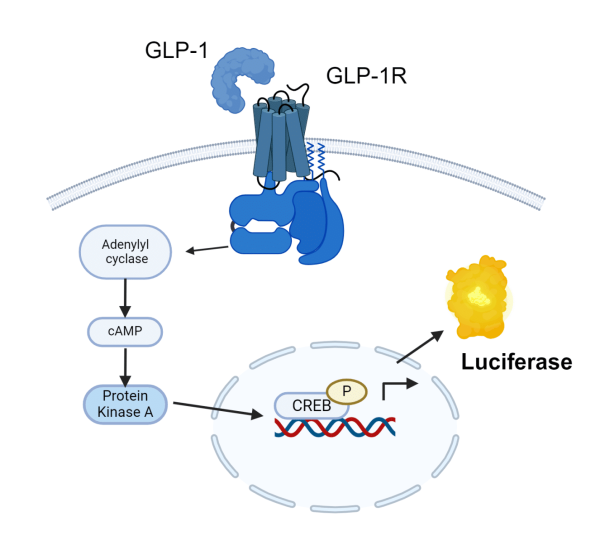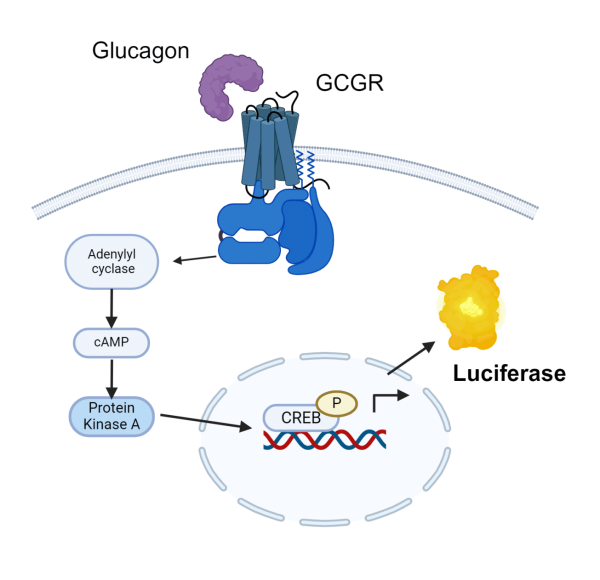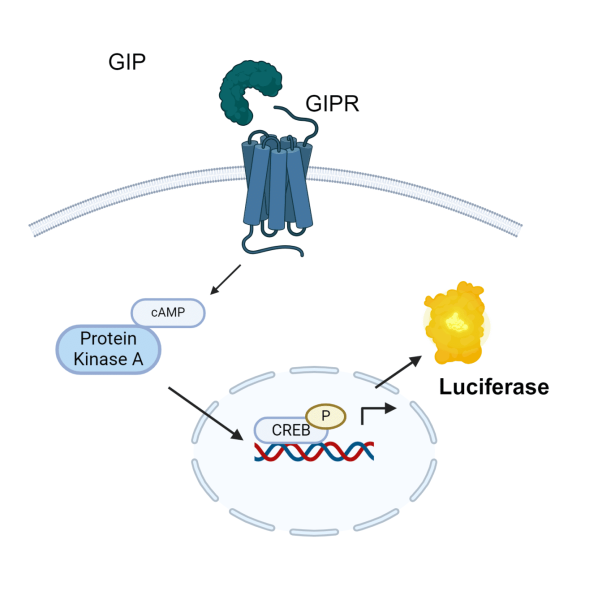
GLP-1R, GIPR and GCGR cell lines for diabetes and obesity research
GLP1-R, GCGR and GIPR are critical receptors known to be important for regulating glucose homeostasis. Studies have shown these receptors provide a promising target for the treatment of type 2 diabetes and obesity using receptor agonists. AMSBIO offers CRE Luciferase Reporter HEK293 cell lines to be able to monitor receptor activity for cell-based binding assays and screening for human receptor agonists.
- Easy quantitation of receptor activity by measuring luciferase activity
- High-throughput screening and profiling of inhibitors, blocking antibodies or activators for drug discovery
- Compliment with our Luciferase assay systems for sensitive and rapid detection of luciferase activity
GLP-1R/CRE Luciferase Reporter HEK293 Cell Line
GLP-1R/CRE Luciferase Reporter HEK293 Cell Line is an engineered HEK293 cell line expressing firefly luciferase under the control of cAMP response element (CRE), and human GLP-1R (Glucagon-like peptide 1 receptor; accession number BC113493). Activation of GLP-1R in these cells can be monitored by measuring luciferase activity.
The functionality of GLP-1R/CRE Luciferase Reporter HEK293 Cell Line was validated in dose-response assays using the peptide agonists Glucagon-like peptide 1 (7-37), Exendin-4, Lixisenatide, GLP-1 moiety from dulaglutide, Semaglutide, Tirzepatide and Retatrutide. This cell line has also been validated in a dose-response assay using a small molecule agonist, Danuglipron.

Created with BioRender.com
Background
GLP-1R, a member of the class B family of G protein-coupled receptors (GPCRs or secretin-like receptors), is a transmembrane protein primarily found in pancreatic β cells and brain neurons and is activated by the peptide hormone glucagon-like peptide 1 (GLP-1) and glucagon that is secreted from intestinal L-cells after nutrient ingestion. GLP-1R plays an important role in controlling blood sugar level by enhancing glucose-stimulated insulin secretion, glucose, lipid metabolism, and satiety. Its role in the brain seems to be in the control of appetite.
Research efforts have focused on the regulation of the GLP-1R mediated signaling pathway as a therapeutic approach to type 2 diabetes (T2DM) and have resulted in the development of several GLP-1 FDA-approved agonists. In addition to their role in insulin secretion, GLP-1R agonists can also contribute to weight management, decrease the potential for cardiovascular diseases and protect beta cells. A role in tumor development in patients with T2DM is also being investigated but further studies are required to fully understand the functions of GLP-1R and its agonists.
| Name | Packsize | Order |
|---|---|---|
| GLP-1R/CRE Luciferase Reporter HEK293 Cell Line | 2 vials | View |
GCGR/CRE Luciferase Reporter HEK293 Cell Line
GCGR/CRE Luciferase Reporter HEK293 Cell Line is a HEK293 cell line that expresses the firefly luciferase reporter, under the control of the cAMP response element (CRE), and human GCGR (Glucagon receptor; NM_000160.5). This cell line was functionally validated with the agonists Glucagon and Retatrutide.

Created with BioRender.com
Background
The glucagon receptor (GCGR) belongs to the Class B1 family of G protein-coupled receptors (GPCR family). Along with GLP-1R (glucagon-like peptide 1 receptor) and GIPR (gastric inhibitory polypeptide receptor), it is one of the critical receptors that regulate glucose homeostasis. Glucagon, the ligand of GCGR, increases insulin secretion via GCGR and GLP-1R in pancreatic β cells, although GLP-1R is the main insulin-promoting receptor. In addition, it has been shown that glucagon enhances hepatic lipid metabolism and reduces food intake in rodents and humans. More recently, encouraging clinical results from a triple-hormone-receptor agonist, Retatrutide, and several GLP-1R/GCGR dual agonists, suggest that GCGR could be a promising co-stimulating target for type 2 diabetes and obesity.
| Name | Packsize | Order |
|---|---|---|
| CGRPR/CRE Luciferase Reporter HEK293 Cell Line | 2 vials | View |
GIPR/CRE Luciferase Reporter HEK293 Cell Line
GIPR/CRE Luciferase Reporter HEK293 Cell Line is an engineered HEK293 cell line expressing firefly luciferase under the control of cAMP response element (CRE), and human GIPR (Gastric Inhibitory Polypeptide receptor; NM_000164.4). The functionality of the GIPR/CRE Luciferase Reporter HEK293 Cell Line was validated in dose-response assays using the agonists gastric inhibitory peptide (GIP), Tirzepatide, and Retatrutide.

Created with BioRender.com
Background
The glucagon receptor (GCGR) belongs to the Class B1 family of G protein-coupled receptors (GPCR family). Along with GLP-1R (glucagon-like peptide 1 receptor) and GIPR (gastric inhibitory polypeptide receptor), it is one of the critical receptors that regulate glucose homeostasis. Glucagon, the ligand of GCGR, increases insulin secretion via GCGR and GLP-1R in pancreatic β cells, although GLP-1R is the main insulin-promoting receptor. In addition, it has been shown that glucagon enhances hepatic lipid metabolism and reduces food intake in rodents and humans. More recently, encouraging clinical results from a triple-hormone-receptor agonist, Retatrutide, and several GLP-1R/GCGR dual agonists, suggest that GCGR could be a promising co-stimulating target for type 2 diabetes and obesity.
| Name | Packsize | Order |
|---|---|---|
| GIPR/CRE Luciferase Reporter HEK293 Cell Line | 2 vials | View |